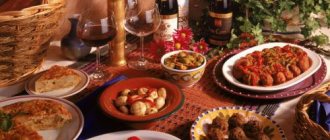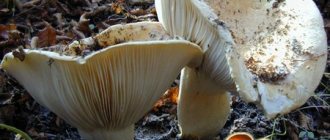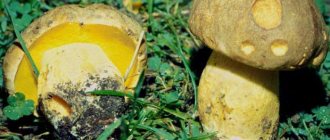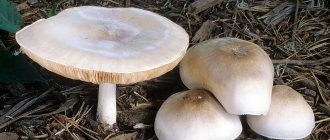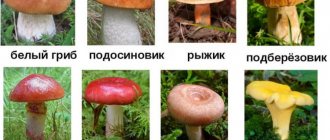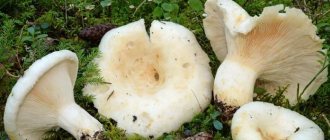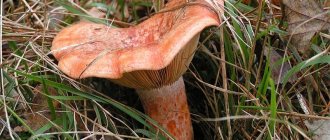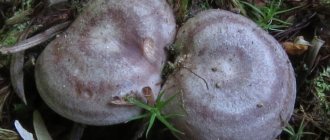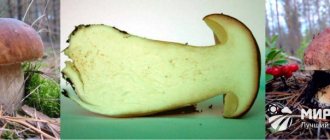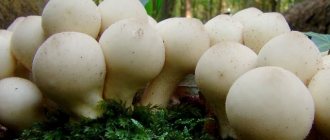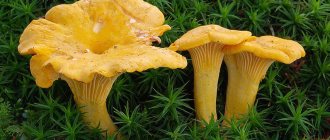Skripitsa: features of the mushroom, its description and photo. Similarities and differences between the violin mushroom and the real milk mushroom and other similar mushrooms. How is the violin used?
Hello dear reader!
Of course, one of the most desirable “mushroom trophies” for a mushroom picker in our forests will be the real milk mushroom (otherwise called white milk mushroom, or still wet).
But wishes don't always come true. It seems like we saw something similar... Something white peeks out from the forest floor. Let's take a closer look.
The violin often “hides” in the grass and forest floor
Alas... Not so! Understandable disappointment - this is not a real milk mushroom at all! So what?
Before us is another representative of the same genus Lactarius (Millery). But this is a much less valuable violin mushroom (Lactarius vellereus).
The benefits and value of the violin
Every person wants to get the maximum benefit from food, but not all products are rich in this, which cannot be said about squeaky mushrooms.
After the mushrooms are properly processed, they lose their harm and saturate the body with vitamins, amino acids and microelements (magnesium, potassium and calcium, and others). Violin contains 49% carbohydrates and 47% proteins. Mushrooms can even be consumed while on a diet, since there are 22 kcal per 100 grams of product.
Mushroom composition:
- proteins;
- fats;
- carbohydrates;
- water.
Minerals:
- calcium;
- potassium;
- iron;
- magnesium;
- phosphorus;
- sodium;
- zinc;
- copper;
- selenium;
- manganese.
Vitamins:
- vitamin C;
- thiamine;
- riboflavin;
- a nicotinic acid;
- choline;
vitamin B6; betaine; vitamin B12; vitamin B; vitamin E; fatty acid.
Regular consumption of properly prepared mushrooms will have a positive effect on the functioning of the gastrointestinal tract, releasing bad cholesterol, lowering blood sugar and improving the functioning of the cardiac system.
Growing at home
The principle of growing violin is not complicated; you just need to purchase ready-made mycelium in the store. This option is more reliable and simpler, but, unfortunately, it is not sold everywhere.
Once the mycelium has been acquired, it is mixed with a preliminary substrate (a mixture of soil and hardwood sawdust). Next, you should collect leaves and moss in the forest, where many squeaky birds grow. Sowing should begin from May to September.
Next, a nutrient solution is made based on yeast and sugar, and the mycelium should be grown on soil closer to forest soil.
Some mushroom pickers plant as follows: overripe mushrooms are broken into pieces and mixed with peat and sawdust and watered with a nutrient solution. The container is covered with a lid, where small holes are made, and set aside for three days at a temperature of 23 degrees.
Before planting, the soil is watered with a lime solution, which should be diluted from 50 grams of lime per 10 liters of water. The holes are made closer to the deciduous wood, the prepared substrate is poured into the hole, filling it halfway. The mycelium is laid out on top and the prepared substrate is added to the top. At the end, moss and leaves are laid out.
You can also grow creaks in a basement or barn. To do this, you should fill a plastic bag with squeaky mushroom mycelium and make holes in it, from where the mushrooms will grow. In this case, they can be collected for 5 years in a row.
Although squeaky mushrooms are not one of the most delicious mushrooms, they can still be eaten. It is quite possible to be confused with some types of milk mushrooms, so you need to know how to distinguish a squeaky mushroom from another mushroom. It is also necessary to properly prepare the squeaks so that there are no problems with the digestive system.
Similar species and differences from them
It is important to know how to distinguish creaks from white and pepper milk mushrooms, as well as podgrudki, what is the difference between them. This will help you choose the right one in the future, since they all differ in taste.
| Violin | Real breast milk (white) | Loader white | Pepper milk mushroom | |
| hat | felt, creaks | densely fluffy, shaggy edges | slightly fluffy edge | almost smooth, not pubescent |
| milky juice | white, bitter taste, yellow when cut, turns brown when dry | white, bitter taste, turns sulfur-yellow when cut | absent, color on the fracture does not change | white, peppery taste, olive green when cut |
| Leg | solid | hollow with age | at first white and solid, with age brownish and hollow, thin felt outside | solid |
| Records | infrequent | infrequent, wide | frequent, thin | frequent, narrow |
A nice feature of the violin is the absence of poisonous doubles.
Mushroom violin - characteristic features
The violin, like the real milk mushroom, is closely connected with the birch in its life. The mushroom forms mycorrhiza with this tree, and grows in forests where there is always a birch tree.
Usually these two mushrooms are found in almost the same areas of the forest. And quite often the mushroom picker is wrong. I was hoping for valuable loot... but what I got was a squeak!
Skripuny, skripukhi - these are even more common names than the “official” name of the mushroom - violin. The mushroom received them for its very characteristic creaking sound, which is heard, for example, when cutting the fruiting body.
What are the most obvious signs of violin mushroom?
Skripitsa is a dense mushroom, often quite large. The diameter of the cap of a mature fruiting body can reach 15–20 cm.
The young mushroom has an almost flat, white cap. Later it becomes funnel-shaped and acquires a yellowish tint. Yellow spots are often visible on the cap of a mature mushroom.
Mature fruiting body of a funnel-shaped violin mushroom
But there are no concentric circles, even if implicitly expressed, like in a real milk mushroom, on the violinist’s cap. The edge of the cap is usually turned up. But the “hairiness” of the edge, by which a real white breast is easily identified, is also not observed in the violinist.
And the surface of the violin mushroom cap is predominantly dry. Unless, of course, you are looking at a mushroom in the rain.
But on the cap there is usually quite a lot of forest debris stuck to it, which is not so easy to clean off.
The stem of the violin mushroom is short and thick, dense.
The violin leg is thick and rather short
The plates are descending, quite sparse and thick. The color of the plates can be white or pale yellow.
These are the plates of the violin mushroom
The cut exudes abundant white milky juice, which slowly turns yellow in the air. Drops of milky juice can also be seen on damaged plates. This juice tastes very bitter.
The violin has abundant bitter white milky juice, gradually turning yellow in the air
The violin mushroom is extremely rarely damaged by insect larvae. Fungus gnats don't like it! However, this does not mean that the mushroom is poisonous.
Comparison of the violin mushroom with similar mushrooms
The easiest way to distinguish between a violin and a real milk mushroom. These mushrooms are similar only from a distance, in their white color. Moreover, the milky juice of the violin and milk mushrooms is bitter, white, and yellowing.
The cap of a real milk mushroom is usually wet and slightly shaggy. There are noticeably more hairs along the edge. Concentric rings are visible on the surface.
This is what a real milk mushroom looks like
The violinist's hat is dry. There are no hairs. Concentric zones are not expressed.
Another bitter milkweed is similar to violin - pepper milk mushroom. I see him here quite rarely. It is predominantly an inhabitant of deciduous forests. But pepper mushrooms form mycorrhiza not only with oak, but also with birch.
Pepper milk mushrooms also have a very bitter milky juice. But in the air it does not turn yellow, but turns blue. And the plates of the pepper milk mushroom are more frequent than those of the violin.
And also, in my opinion, the bitterness of pepper milk mushrooms cannot be removed by any soaking or boiling. I remember soaking it for five days, but the mushroom remained bitter after salting!
Externally, many people are similar to the violin mushroom, white podgrudok, otherwise called “cracker”. The same large white funnel-shaped fruiting bodies. And there is always a lot of debris on the hat.
But there is no milky juice (hence the “cracker”). And there is absolutely no bitterness. And in general - the podgruzka belongs to another genus - Russula (i.e., Russula). And you can fry the loading immediately, only after bringing it from the forest. But more often than not, the “crackers” come across as extremely wormy.
Doubles
In nature, there are many types of mushrooms that are similar to each other. There are also those that look like milk mushrooms:
Spruce row Tricholoma Aestuans
This mushroom likes to grow on mossy soil in damp coniferous forests, from late August to October. The cap has a characteristic tubercle and is colored brown. The mushroom has an extremely unpleasant taste and smell, which is why it is considered inedible. There are known cases of mild food poisoning when eating this mushroom. This species is easily distinguished from milk mushrooms by the color of the cap and the absence of milky juice.
Common milkweed Lactarius trivialis
This species is also known as Gladysh. Its cap reaches a diameter of up to 15 cm and has a funnel shape. Its color varies from brown to almost lilac or purple, and the surface can be smooth or slimy. The hymenophore is lamellar, the plates are painted in pale cream shades and are often located. Spore powder is light yellow. The stem is slightly lighter than the cap and can grow up to 15 cm. The flesh is thick and yellowish, secretes a white milky juice that turns yellow in the air.
The milkweed is quite suitable for food after preliminary preparation. Just like milk mushrooms, this mushroom is very good when salted.
Using the violin mushroom
It’s hard to say that milk mushrooms and violin taste similar. They are rather radically different. Regular breast milk is considered more valuable in terms of healthiness and taste.
In addition, the violin needs long-term cooking. Collected mushrooms are used for cooking only after preliminary soaking in one of two ways:
- in cold water for 5 days, periodically changing it to fresh water;
- in hot water, draining it and replacing it with a new one every 4 hours.
The hot soaking method helps to reduce the time at the preparatory stage, since the mushroom will be ready for further use after just 3 days.
Both methods are aimed at removing the unkempt bitter taste from the mushroom pulp. But even after this they are only suitable for pickling. They can be eaten immediately or stored in jars for the winter. The ideal temperature for storage is +15 degrees.
Before salting, the creaks need to be soaked well under pressure for 5 days to remove the bitterness. But you must ensure that the water does not become sour and change it regularly. If you fill the mushrooms with boiling water rather than cold water, the soaking time is reduced to 2-3 days.
Banks need to be prepared especially carefully. They must be washed with water and soda, rinsed well and sterilized over steam for 20 minutes. Plastic lids need to be boiled for at least 2 minutes.
Preparation:
- Fill prepared clean jars tightly with mushrooms, caps down, sprinkling them with salt. Since the creaks have been soaked for a long time, when placed in a jar they will release liquid, which should cover them completely.
- If desired, you can add cloves and bay leaves.
- It is advisable to cover the top of the jars with currant leaves to prevent mold.
Store jars in the refrigerator for 7 weeks. During this time, the bitterness should completely go away. The duration of pickling depends on the pulp: in old mushrooms it is hard, so it will take longer to pickle. If the brine level decreases, fresh water and salt must be added to the jars (per 1 liter - 20 g).
The best recipes for preparing dishes and preparations
Salted milk mushrooms
All milk mushrooms are suitable for food after soaking for two to three days, and the water is changed several times, adding fresh water. This is the only way to get rid of the bitter taste of pulp and acrid juice. Pickled fruit bodies are not only an exceptionally tasty snack, they are an excellent preparation for first courses and stewing.
Pickled black milk mushrooms
For 5 kg of prepared mushrooms, take 200 g of salt, blackcurrant leaves, garlic, dill, black peppercorns and other herbs and spices to taste.
Pickles can be prepared using the cold method, and then the preparation will be more tasty, and using the hot, faster method.
Cold salting
The cleaned fruiting bodies are immersed in cold water for three days, which is replaced several times a day. After this, they are placed with their caps down in a vessel, sprinkling the rows with salt and spices, covered with a cloth and a load is placed. The shelf life of pickles is 30–45 days.
Hot salting
The mushrooms are boiled until tender and placed in a suitable container, sprinkled with salt, spices and pressed down with a weight, as in the previous case. With this method, the pickles are prepared for two weeks.
Canned pickles
For one liter jar of preserves, take 4 tablespoons of 5% vinegar, salt, black pepper, and several bay leaves. Prepare hot brine at the rate of 20 g of salt per 1 liter of water.
Mushrooms salted for 30–45 days are placed in a colander, inspected, removing damaged fruiting bodies, and washed with running water. As soon as the water has completely drained, the workpiece is placed in jars on a layer of spices, then vinegar and the prepared hot brine are poured. The preservation is placed for sterilization, keeping the liquid in the jars at a boil for at least one hour, then sealed.
Pickled milk mushrooms
For 5 kg of prepared mushrooms take 200 g of salt, 300 g of sugar, 400 g of sour milk.
The fruiting bodies are cut into pieces, dipped in hot water, salted to taste, boiled for two minutes and drained in a colander. Place it in a vessel in layers, add salt, add sugar, press down, releasing excess air, and pour in sour milk, covering the fermentation with a cloth, and place a weight on top.
At a temperature of 17–19°C, the product can be consumed after two weeks. For long-term storage, the workpiece is packaged in jars, filled with brine at the rate of 20 g of salt per 1 liter of water and sterilized for 40–50 minutes, after which it is sealed.
Favorite in folk cooking, milk mushrooms, thanks to their inimitable aroma, excellent taste properties, and undoubted nutritional value, deserve the closest attention of mushroom pickers. Obvious advantages - excellent yield, absence of poisonous look-alikes and high transportability make this species one of the best trophies for lovers of “silent hunting”.
You will learn more about milk mushrooms and their distinctive features from the video.
Description
Lactarius vellereus, or felt milk mushroom, creaker, violin, milk scraper or milkweed - this is also the name of this conditionally edible organism. A white juice with a peculiar aroma is released from its cut.
It belongs to the 4th category of edibility, to the Agaricomycetes class, the Milky genus and the Russula family.
Description of Lactarius vellereus:
- funnel-shaped cap;
- edges are cracked;
- size - from 7 cm to 25 cm;
- color milky white;
- the flesh is hard and brittle;
- turns yellow when cut;
- leg up to 5 cm in height, 4-5 cm in diameter;
- leg color is pure white;
- the plates are sparse (the distance between them is 0.5-1 cm).
The caps of young violin mushrooms have cracked, shaggy edges bent to the stem. The name “felt” mushroom received its inherent slight hairiness on the surface of the cap. The plates underneath are light cream, delicate and fragile.
By the way. The cap of the violin is characterized by variability: it can acquire a yellowish or reddish-brown tint with ocher spots, and the plates can be greenish or yellow and sometimes with the presence of ocher spots on the surface, like the cap.
The leg tapers towards the ground. If you cut it, a milky juice is released, which gradually dries out and does not change its color. Dry juice looks dull.
When they come into contact with each other in the basket or when running a finger over the cap, a characteristic creaking sound is heard, hence the name creaking mushrooms.
Skripitsa is a mushroom that lives in coniferous and mixed forests. Where there is a lot of moss, old rotted leaves and enough lighting. The mushroom loves to settle at the foot of birch and aspen trees. It often forms mycorrhiza with birch trees, and it is typical for it to form mycorrhiza with various types of coniferous and deciduous trees. Whole families grow in summer and autumn.
It has several similar species, so when harvesting it is important to understand their differences, although none of them are poisonous. Irina Selyutina (Biologist):
Irina Selyutina (Biologist):
The creaking mushroom has, so to speak, a twin mushroom - Bertillon's milkweed (Lactarius bertillonii). Externally, it is almost impossible to distinguish them. The only difference is the taste of the milky juice - soft and only slightly tart in the violin and very hot in the Bertillon milkweed. To determine species differences, you can also take a solution of potassium hydroxide (KOH): when interacting with it, the milky sap of Bertillon's laticifer (this reaction is not typical for the violinist) changes its color: first it becomes yellow, and then orange.
Types of “scraper” include:
- aspen creaking;
- real milk mushroom;
- pepper milk mushrooms;
- loading
The real milk mushroom differs from the violin by the shaggy edges of the cap, a hollow stem (in old specimens) and rare plates under the cap, which are exclusively white (but in the violin they are light yellow). In addition, in milk mushrooms the milky juice turns yellow when it comes into contact with air, but in milk mushrooms it remains the same.
Squeaky mushrooms have a bitter milky juice. According to the description, the edges of the cap of the caps are fluffy, not torn, and the stem becomes hollow and brown with age. Thin plates are located frequently.
The surface of the pepper milk cap is smooth, without villi and scales. The juice when crushed has a green color with an olive tint and a peppery aroma. The leg is dense and solid. The plates of the pepper mushroom are thin and narrow, often located.
Distribution and collection
The distribution area of this fungus is throughout the entire territory of deciduous and mixed forests of the European temperate zone, Siberia and the Far East. Most often found in numerous groups, including specimens of different ages; it is very rare to see a violin alone.
Skripun.
The violin collection season is throughout the summer-autumn season.
Harm and contraindications
In natural conditions, mushrooms are sponges that freely absorb and accumulate harmful substances from the atmosphere, soil and groundwater. It is better not to collect them near roads and factories, near residential areas.
Among the negative properties is the severity of digestion, which is formed by the presence of chitin in the cell walls of the fungus. If mushrooms are not prepared correctly, heaviness, cramps and pain in the stomach appear after eating them.
Children should not include such foods in their diet without consulting a pediatrician due to the severity of digestion and excess salt. Pregnant women should not eat salted mushrooms: they retain water in the body and lead to unwanted swelling.
Preparation
Often this type of mushroom, known as squeaky mushrooms, is also called false milk mushroom. However, this is not entirely true, since this species is quite edible, and its taste is no worse than that of other wild mushrooms. Its preparation involves a rather lengthy process - but it's worth it. First of all, it is necessary to clean the fruiting body from adhering grass and foliage.
Skripitsa, like milk mushrooms similar to them, taste best when marinated or salted. Salted mushrooms acquire a characteristic creaking, aroma and elasticity
It is important to take into account that the older the mushrooms in the harvested crop, the longer the pickling process should take place. As a rule, its duration does not exceed 1-2 months
Also, one should not forget about carrying out such processing of the fruiting bodies of the violin, such as removing the bitter-burning milky juice. To do this, peeled mushrooms are soaked for several days in cool water (for at least 3 days, the water should be changed 2 times a day).
Prepared felt milk mushrooms are boiled in salt water for several tens of minutes. After this, you can start marinating. After 7-10, the prepared violins are rolled into sterilized glass containers.
Both salted and pickled mushrooms of this type should be stored in a cool and dark place. Like their closest relatives, violin milk mushrooms are not subjected to such processing as drying.
Edibility, beneficial properties and restrictions on consumption
Skripitsa belong to category 4 of the nutritional value of mushrooms. They are representatives of the conditionally edible group. The use of violin fruits for food is possible only after the following preparation:
- Soaking. Mushrooms are filled with water and left for up to 5 days. It is recommended to replace the water with fresh water 2-3 times a day. Soaking is necessary to get rid of the caustic milk contained in the squeaky fruits.
- Boiling. Like all other conditionally edible types of mushrooms, violins must be subjected to heat treatment. During boiling, dangerous protein compounds in the fruits are destroyed, which cause food poisoning.
Prepared squeakers go to salting. The mushrooms turn out strong, crispy, and slightly squeaky on the teeth.
Violins have useful properties. The composition contains a lot of fiber, vitamins and minerals necessary for the normal functioning of the human body. One serving of mushrooms can replenish the daily requirement of phosphorus, iron, potassium and sodium.
Good to know! Systematic consumption of the product leads to a decrease in blood sugar and cholesterol levels. The body's resistance to viruses and bacteria improves. Violins have a beneficial effect on the human immune system.
In addition, these mushrooms contain a natural antibiotic. In folk medicine, squeaks are used to treat joints.
Some groups of people should refrain from eating violin dishes. These are, of course, children, women during pregnancy and breastfeeding, as well as people with gastrointestinal problems. For gastritis, gastric ulcers and low acidity, creaks are also contraindicated.
The place where the violins are collected also matters. Fungi of this species tend to absorb substances from the external environment, including those of a toxic nature. Collecting squeaks is only possible in places remote from busy highways and industrial facilities.
Skripitsa is a conditionally edible mushroom. Preparing dishes from its fruits is complicated by certain stages of product preparation. This mushroom has an inedible counterpart - Bertillon's milkweed. It can also be mistaken for representatives of white milk mushrooms and white trumpets.
Use
In Russia, violin is classified as a low, fourth, category of mushroom, but in the West it is considered completely inedible. Skripukha is consumed only in salted and fermented form, having previously been subjected to a soaking process. Mushrooms brought from the forest are cleaned of debris, washed and the stems are trimmed to fit the base of the cap. Even after proper salting, squeaky mushrooms retain a rather mediocre taste with a somewhat sour aroma, characteristic of salted lamellar mushrooms.
However, they bring tangible benefits to the human body due to their unique composition and active ingredients that have a beneficial effect on the functioning of vital organs. With the help of salted and pickled squeaks, you can significantly diversify your winter-spring diet. Salted milkweed retains its white color with a slight bluish tint, remaining strong, hard, and slightly creaky on the teeth. It smells like real mushrooms. Such mushrooms are not eaten boiled, stewed or fried.
Important! Children under 3 years of age are strictly prohibited from eating mushroom dishes. They are given to an older child very carefully, in small portions. However, children at any age are still advised to refrain from eating conditionally edible mushrooms, in particular violin mushrooms.
How is the violin mushroom used?
Skripitsa is a conditionally edible mushroom. It can be eaten if pre-treated.
The violin is usually used for salting or pickling. Of course, most often this is done “without mushrooms.” I also sometimes salt the violin if I don’t find anything more “noble.”
Even the black milk mushroom suits me better when salted than the violin mushroom. We're so picky!
But if you still decide to pickle the violin, the steps will be as follows.
We clean the mushrooms from debris. You can even fill them with water first and leave them to soak for a while.
Choose the salting method - cold or hot.
In the first case, we soak the mushrooms for three days, placing them in some kind of tank or large pan. It is best to arrange a slight oppression so that the violins do not float up. We change the water daily. You can do it twice a day.
In the second case, boil the mushrooms for half an hour.
After soaking or boiling, we proceed to salting. The method of salting violin is practically no different from how it is usually done with other bitter milkweeds: pink trumpet, various milk mushrooms. Valui (“bull”) is salted in the same way.
To pickle violin (as well as other mushrooms) we use an enamel pan, a stainless steel pan or ordinary glass jars.
Place currant or horseradish leaves at the bottom of the container chosen for pickling mushrooms. Lay out the mushrooms in layers, sprinkling with salt. The most suitable amount of salt is a heaped tablespoon per 1 kg of soaked or boiled mushrooms.
However, you can take more salt - about one and a half tablespoons per 1 kg of mushrooms.
You can also place leaves on top. Then we arrange oppression. The mushrooms must be completely covered with brine, otherwise they will spoil (mold will develop).
When using a pan, we either make a circle of wood to size, or select something that replaces it. As an option - a shallow plate of suitable diameter. We place some kind of stone on a circle (plate) - fine-grained and dark gray in color.
When using glass jars, oppression can be achieved using a plastic bottle of water. Or insert a soft plastic lid into the neck of the jar, and then unfold it.
Cold-salted mushrooms, after soaking, are ready for consumption in a month to a month and a half. You can try salted ones after boiling earlier.
The violin mushroom also has medicinal properties. True, the mushroom has not been used and is not used in our folk medicine.
However, research shows that alcoholic extracts of fresh fiddlehead fruiting bodies have anti-inflammatory and antitumor effects.
So the violin is a “so-so” mushroom. But it's not that simple!
Skripitsa is a conditionally edible mushroom, that is, one that requires specific processing to become edible. It belongs to the genus of laticifers, and the mushroom received its characteristic name due to the fact that when you touch the cap, it makes a creaking sound. Popularly, this mushroom is also called spurge, and in most civilized countries it is considered inedible, which, in general, is correct. This type of mushroom is quite common in Russia; it is white in color with a large cap, which sometimes grows up to 25 centimeters in diameter. The cap is quite massive, a hole is formed in the center, and the cap is reddish in color. The leg is low and quite thick: usually 5 cm in height and the same in diameter.
The violin very rarely attracts the attention of insects or worms, just like an ordinary milk mushroom, so some mushroom pickers still collect it for further use. It reproduces by spores, which are located in the plates at the bottom of the cap.
The fact that violin is classified as a conditionally edible mushroom has come to us since the times of the USSR, where this mushroom was included in GOST as edible after pickling. However, most foreign mushroom pickers, as well as scientists, classify it as an exclusively inedible mushroom, and, in general, they do the right thing. Unlike milk mushrooms, violin does not have a pleasant taste; even after prolonged salting and boiling, it remains extremely mediocre in taste and very few people like it. Salting is necessary in order to get rid of violin juice, which can be considered conditionally poisonous; it has a very bitter and unpleasant taste.
Biological characteristics of the mushroom, and the history of the name
- Belongs to the kingdom of mushrooms
- Belongs to basidiomycetes
- Class Agaricomycetes
- Russula order
- Russula families
- In the genus of the milkmen
Other names: violinist, podsukhar, milkweed, milk scraper, euphorbia, violinist, aspen creaker, skreukukha.
Skripnitsa mushroom is almost like milk mushroom, only healthier
This mushroom got its name because of its unusual ability to creak when the caps of other violin milk mushrooms come into contact with it. Squeakers also produce distinctive squeaks for their species and secrete a milky, acrid juice when cut with a knife.
Beneficial features
Mushrooms lower cholesterol
Like other forest mushrooms, the tomentose mushroom, or violin mushroom, has many beneficial properties that are determined by its composition. It contains a lot of fiber, vitamins and minerals necessary for the human body.
One serving of properly prepared milkweed can meet your daily needs for phosphorus, iron, sodium and potassium.
Periodic consumption can normalize cholesterol levels and lower blood sugar levels.
Skripun supports the general condition of the body, serves as a natural antibiotic and helps fight viral and bacterial diseases. It contributes to the overall strengthening of the immune system and restores a person’s energy balance.
Despite its low calorie content (22 kcal per 100 g), the mushroom gives a quick feeling of fullness. When following a diet for weight loss, it is used as a protein substitute for meat or fish.
Description of the squeaky mushroom
Skripitsa is a large mushroom; in adulthood, the diameter of the cap can reach up to 17 centimeters. In young specimens, the cap is convex in shape and pure white in color, but as it matures it straightens and then becomes funnel-shaped, with the edges becoming wavy. The color of the cap becomes noticeably yellower with age. The cap is fleshy and dense.
Under the cap there are sparsely located yellow plates. In mature mushrooms, the plates become lighter. The pulp is hard, brittle, white. If you break it, white juice comes out. This juice, as noted, is very caustic. Fresh mushrooms do not have a specific smell.
The violin's leg is solid and painted white. Its height is no more than 6 centimeters. It narrows towards the base. The leg is thick and short, and its surface is covered with fluff, which is why the mushroom is popularly called a felt mushroom.
Places where violin grows
Violin mushrooms are very common mushrooms. They grow next to the mushroom floats. The violin can be found under single birch and aspen trees. These mushrooms prefer well-lit places.
Creaking mushrooms grow on soil covered with dry leaves or moss. These mushrooms are most likely to be found at the forest edge. They are found in numerous groups, consisting of specimens of different sizes and ages. In one place they can find from young mushrooms to overripe ones.
Fruiting begins in July and lasts until October. But it is almost impossible to meet mushroom pickers who specifically collect squeaky mushrooms, since they are considered to be of very low quality.
How to distinguish a violin from a white milk mushroom?
As mentioned, creaking mushrooms are collected by mistake, confusing them with white milk mushrooms. But there are several differences that make it possible to understand that these are completely different mushrooms: • The creaking mushroom in the lower part of the cap does not have a fringe, characteristic of white milk mushrooms; • The plates under the cap of milkweed are light yellow, while those of milk mushrooms are white; • The violinist secretes milky juice, which remains practically unchanged in the air, but in the milk mushroom it turns yellow; • To the touch, the violinist is much stiffer and stronger in comparison with the milk mushroom.
Eating violin
In our country, violin mushrooms are classified as edible mushrooms, but of the 4th category, and in the West they are considered inedible and unfit for consumption, which is quite reasonable. In our forests in the fall you can almost always find violins in abundance.
Connoisseurs of exotics pickle violins; before doing this, it is recommended to soak the mushrooms for at least 5 days, draining the water regularly. After this, the mushrooms are boiled and only then salted. Mushrooms are soaked to remove the milky juice from them. Although the taste of these mushrooms is mediocre, craftsmen can process them so correctly that in their finished form it becomes difficult to distinguish them from white milk mushrooms.
When salted, squeaky mushrooms are white with a slightly bluish tint. They are strong, slightly squeak on the teeth while eating and smell like milk mushrooms. The great advantage of the violin is that it has no poisonous counterparts.
How do milk mushrooms differ from milk mushrooms?
It grows from the end of August until the first frost, mostly alone in birch forests and mixed forests, mainly in the northern part of the forest zone. The cap is up to 12 cm in diameter, at first flat with a hole in the center and with a rolled edge, later funnel-shaped, fibrous, shaggy and woolly along the edge. Let's figure out how milk mushrooms differ from milk mushrooms and how to differentiate them in the field.
In wet weather, the middle of the cap is sticky, pink or yellowish-pink, with pronounced dark concentric zones. The plates are adherent or descending, thin, white or slightly pinkish. The leg is up to 6 cm long, up to 2 cm in diameter, cylindrical, hollow, one-color with a cap. The pulp is loose, brittle, white or pinkish, with white, pungent, acrid milky juice. Volnushka is used for salting. It is pickled only after thorough soaking and boiling, otherwise the mushrooms can cause severe irritation of the gastric mucosa. It is best to take young mushrooms for pickling, up to 3–4 cm. Their cap is strong, with the edge curled deep inside. Such small waves are called “curls”. When salted, it has a pale brown color with an admixture of pink, and retains pronounced dark zones. In the northwestern and central regions of the country and in the Urals, usually on the edges of young birch forests from the beginning of August to October you can find the white moth. It is in many ways similar to the pink wave, but smaller. The cap, up to 6 cm in diameter, is fluffy-silky, at first convex, later funnel-shaped, white with yellowish-reddish, blurry spots, with a curled hairy edge. The white milky juice is pungent and sometimes bitter. The plates are light fawn, slightly pinkish, adherent or descending, frequent, narrow. The leg is dense, brittle, short, smooth. The flesh is white or slightly pinkish. Belyanka is sometimes confused with white podgruzdka. But the latter has a much larger cap, and the edge is bare or slightly pubescent. It is only used for pickling after preliminary soaking in water or scalding with boiling water. Belyanka is valued for its delicate pulp and pleasant taste. When salted it is light brownish. The mushroom is conditionally edible, second category.
Proper processing
As soon as the mushrooms have been brought home from the forest, the first thing they should do is sort them out and free them from adhering leaves and other dirt. Next, the mushrooms are washed and soaked in salt water. After this, the creaks can be boiled, fried, stewed, made various sauces, dried or pickled, but all this after preliminary boiling.
Soaking lasts 5 days in cold, clean water. This must be done if you decide to pickle mushrooms or cook them in any other way. During this time, the water should be changed several times to clean water.
In addition to the fact that the mushroom contains many useful substances, it also contains harmful components that make the fresh mushroom bitter.
It’s not even a matter of taste; if this mushroom is simply boiled or fried, then attacks of nausea and vomiting and gastrointestinal poisoning may occur, which is why it is so important to pre-soak and dry or pickle them
Evaluation of taste qualities, medicinal properties, benefits and possible harm
The taste of fresh violin is quite pungent, with a significant aftertaste of bitterness, which does not disappear even after heat treatment. It contains trace elements that irritate the gastrointestinal tract and cause a gag reflex, so this mushroom should not be consumed raw.
But after proper processing, the fruiting body gets rid of harmful substances and is able to supply the body with amino acids, fiber, vitamins and minerals. One serving contains the daily dose of iron, sodium, phosphorus and potassium. And the low calorie content (22 kcal per 100 g) makes this mushroom suitable for dietary nutrition.
Frequent consumption of felt milk mushrooms contributes to:
- normalization of cholesterol and blood sugar levels;
- maintaining good health;
- general strengthening of the immune system;
- restoration of energy balance;
- protection against viral and bacterial diseases.
Due to its rich chemical composition, violin is widely used in folk medicine. In China, it is used to treat pain in the joints, tendons of the limbs and pelvic bones.
But there are a number of contraindications:
- gastrointestinal diseases;
- liver and kidney diseases;
- gout;
- allergic reactions;
- pregnancy and lactation period.
Description
Lactarius vellereus, or felt milk mushroom, creaker, violin, milk scraper or milkweed - this is also the name of this conditionally edible organism. A white juice with a peculiar aroma is released from its cut.
It belongs to the 4th category of edibility, to the Agaricomycetes class, the Milky genus and the Russula family.
Description of Lactarius vellereus:
- funnel-shaped cap;
- edges are cracked;
- size - from 7 cm to 25 cm;
- color milky white;
- the flesh is hard and brittle;
- turns yellow when cut;
- leg up to 5 cm in height, 4-5 cm in diameter;
- leg color is pure white;
- the plates are sparse (the distance between them is 0.5-1 cm).
The caps of young violin mushrooms have cracked, shaggy edges bent to the stem. The name “felt” mushroom received its inherent slight hairiness on the surface of the cap. The plates underneath are light cream, delicate and fragile.
By the way. The cap of the violin is characterized by variability: it can acquire a yellowish or reddish-brown tint with ocher spots, and the plates can be greenish or yellow and sometimes with the presence of ocher spots on the surface, like the cap.
The leg tapers towards the ground. If you cut it, a milky juice is released, which gradually dries out and does not change its color. Dry juice looks dull.
When they come into contact with each other in the basket or when running a finger over the cap, a characteristic creaking sound is heard, hence the name creaking mushrooms.
What is the difference between a false breast and a real one?
The first thing that distinguishes a false breast from a real one is a cap with a diameter of 4-12 cm, densely fleshy, convex or flat-spread to funnel-shaped, sometimes with a tubercle, initially with a bent edge, and later with a drooping edge, dry, silky-fibrous, finely scaly, with age almost naked, ocher-meaty-reddish, ocher-dirty-pinkish-gray or pinkish-brownish, with vague spots when drying.
The plates are descending, narrow, thin, whitish, later pinkish-cream and orange-ocher. The stalk is 4–8×0.8–3.5 cm, cylindrical, dense, eventually hollow, tomentose, hairy-tomentose at the base, the color of the cap, lighter in the upper part, mealy. The pulp is yellowish with a reddish tint, the lower part of the stem is reddish-brownish, sweet, without much odor (when dried, it smells of coumarin); The milky juice is watery, sweet or bitter, and does not change color when exposed to air. Grows in moist coniferous and deciduous forests. Fruiting bodies are formed in July – October. Poisonous mushroom. Watch how to distinguish a white milk mushroom from a false one in the video, which shows all the features.
